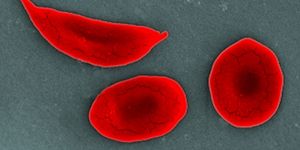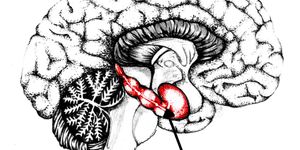What does the eye say about the psyche? Researchers at Rutgers University and Mount Sinai’s New York Eye and Ear Infirmary believe that tracking changes in the eye’s retina may help doctors provide
more effective treatment for people with schizophrenia.

There is a link between vision problems and schizophrenia, with as many as 62 percent of adult patients with schizophrenia having visual distortions involving form, motion or color. Researchers provided evidence of multiple, replicated indicators of eye abnormalities in schizophrenia in a literature review published online in the journal Schizophrenia Research: Cognition, which was summarized in
Bioscience Technology.
The researchers discussed a widening of small blood vessels in the eyes of schizophrenia patients, and in young people at high risk for the disorder, perhaps caused by chronic low oxygen supply to the brain. They believe that this could explain vision changes and signal disease risk and progression. The researchers also discovered a thinning of the retinal nerve fiber layer, known to be related to the onset of hallucinations and visual acuity problems in patients with Parkinson’s disease.
According to study co-author Richard B. Rosen, director of ophthalmology research, New York Eye and Ear Infirmary of Mount Sinai, and an ophthalmology professor at the Icahn School of Medicine at Mount Sinai, “Our analysis of many studies suggests that measuring retinal changes may help doctors in the future to adjust schizophrenia treatment for each patient. More studies are needed to drive the understanding of the contribution of retinal and other ocular pathology to disturbances seen in these patients, and our results will help guide future research.”
People with schizophrenia have difficulties with social interactions and in recognizing what is real because of abnormalities in the way the brain processes visual information. It is more difficult for them to “track moving objects, perceive depth, draw contrast between light and dark or different colors, organize visual elements into shapes and recognize facial expressions,” according to various research reports. A previous study also found that “poorer visual acuity at age 4 predicted a diagnosis of schizophrenia in adulthood, and another that children who later develop schizophrenia have elevated rates of strabismus, or misalignment of the eyes, compared to the general population.”
Rosen and co-author Steven M. Silverstein, director of the division of schizophrenia research at Rutgers University Behavioral Health Care and Robert Wood Johnson Medical School Department of Psychiatry, looked at the results of about 170 existing studies. They assembled the findings into multiple categories, including changes in the retina compared with those in other parts of the eye, and changes related to dopamine compared with those related to other neurotransmitters, important brain chemicals associated with the disease.
Silverstein concluded, “Because it is much faster and less expensive to obtain data on retinal structure and function, compared to brain structure and function, measures of retinal and ocular structure and function may have an important role in both future research studies and the routine clinical care of people with schizophrenia.”









